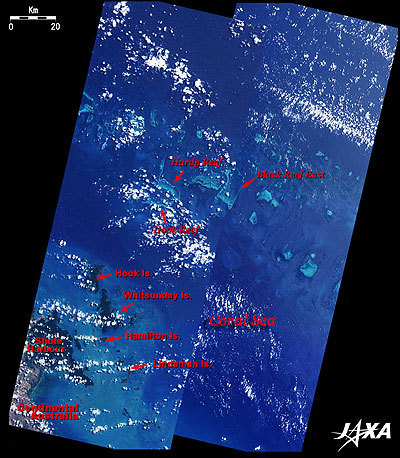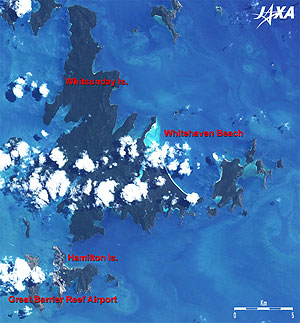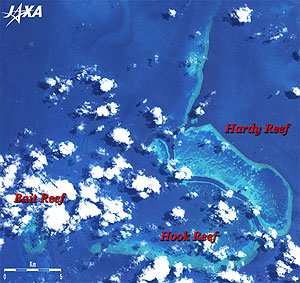Seen from Space 2007
Splendid blue islands - The Great Barrier Reef, Australia
Coral is a marine animal species similar to the sea anemone. Some types of coral, reef-building coral, form a hard skeleton of calcium. The Great Barrier Reef, which is visible from space because of the aggregation of coral skeletons, is biggest life of the Earth. The Great Barrier Reef is a coral reef lying off Australia's east coast as if protecting it. Captain Cook (a Navy Lieutenant on that voyage) had been struggling to reach the continent when he discovered the Great Barrier Reef in 1770. The Great Barrier Reef consists of four sections from north to south, the Far North, Cairns, Central, Mackay and Capricorn. Figure 1 depicts the vicinity of Whitsunday archipelago in the Central section. The archipelago, consisting of 74 islands, is located in the center of Queensland State, 1,100km north of Brisbane, the capital of Queensland State, and 700km south of Cairns, a major city of Queensland. It takes one and a half hours to fly from either Brisbane or Cairns by jet. Driving takes 13 hours from Brisbane or 8 hours from Cairns along the scenic Bruce Highway with its beautiful view of the Australian landscape. Brisbane and Cairns are not visible in this figure. Many places in the Great Barrier Reef are designated as Australian national parks and are protected; these places were registered as world natural heritage sites in 1981. All four criteria for selection as a natural heritage site were satisfied. The Great Barrier Reef is a true treasure of the Earth. In July 2004, the Australian government increased the protected area in the Great Barrier Reef, from 4.5% to 33.3%.
The bottom of Fig. 2 depicts Hamilton Island when it opened in 1964 as a residence area and resort area. Even now, about 70% of the island is protected as a national park. There are only 20 resorts on the Great Barrier Reef. The Great Barrier Reef Airport on the island is the only airport that can accommodate jet airplanes on Great Barrier Reef. There are direct flights from Sydney, Melbourne, Brisbane and Cairns and ships from Shute Harbour on continental Australia.
Most coral in the Great Barrier Reef live in the area at the upper limit of the water temperature tolerance. Coral bleaching (1) in the Great Barrier Reef was induced by global warming from 1998 to 2002. We should endeavor to limit global warming in order to preserve the beautiful natural environment for the future. Using Earth-observation satellites, it is possible to monitor the trend of coral bleaching by periodically observing the coral reefs.
|







